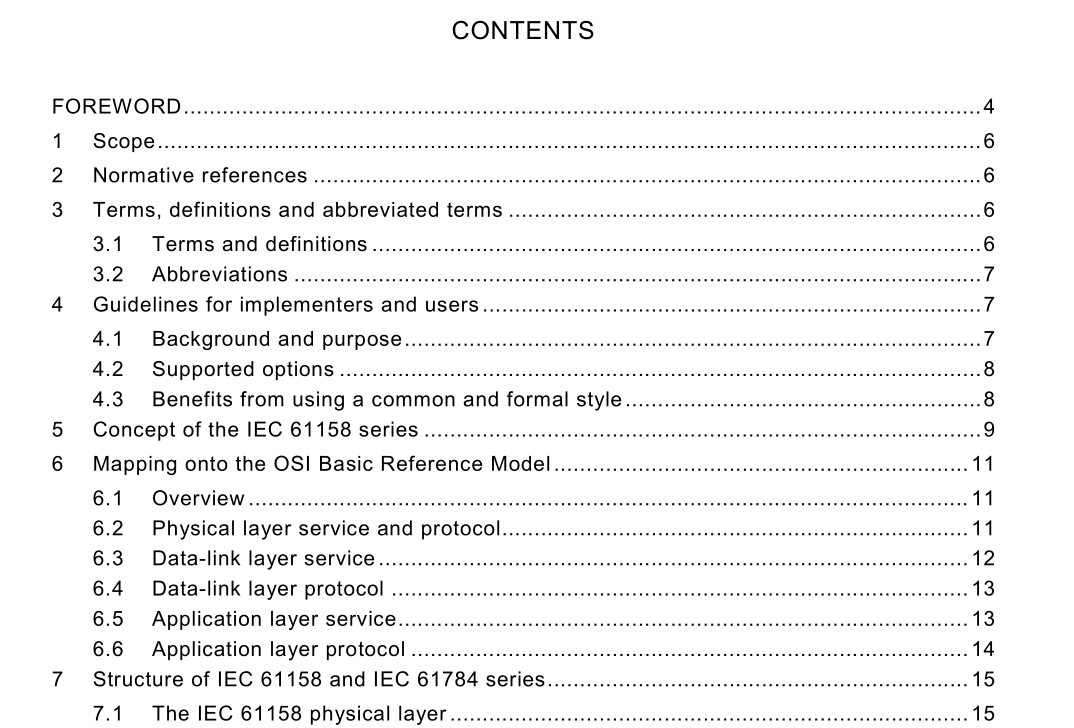IEC 61158-1 pdf download.INDUSTRIAL COMMUNICATION NETWORKS – FIELDBUS SPECIFICATIONS
1 Scope
This document specifies the generic concept of fieldbuses. This document also presents an overview and guidance for the IEC 61 1 58 series by: • explaining the structure and content of the IEC 61 1 58 series; • relating the structure of the IEC 61 1 58 series to the ISO/IEC 7498-1 OSI Basic Reference Model; • showing the logical structure of the IEC 61 784 series; • showing how to use parts of the IEC 61 1 58 series in combination with the IEC 61 784 series; • providing explanations of some aspects of the IEC 61 1 58 series that are common to the type specific parts of the IEC 61 1 58-5 including the application layer service description concepts and the generic fieldbus data types.
3 Terms, definitions and abbreviated terms
3.1 For the purposes of this document, the following terms and definitions apply. 3.1.1 communication system arrangement of hardware, software and propagation media to allow the transfer of messages from one application to another 3.1.2 fieldbus communication system based on serial data transfer as typically used in industrial automation and process control applications 3.1.3 fieldbus system system using a fieldbus with connected devices 3.1.4 message ordered series of octets intended to convey information [SOURCE: ISO/IEC 2382-1 6:1 996, 1 6.02.01 , modified]
4 Guidelines for implementers and users
Background and purpose Communication in global markets requires a global understanding of a specification (standard or not). ISO/OSI related specifications provide a common basis for understanding and acceptance between international experts (manufacturers and end-users).The IEC 61 1 58 series specifies a number of different fieldbus types in each of its parts (IEC 61 1 58-2 and the type specific parts of IEC 61 1 58-3-tt, IEC 61 1 58-4-tt, IEC 61 1 58-5-tt and IEC 61 1 58-6-tt). As a result of the editorial harmonization work done by IEC, each PhL, DLL and AL specification within IEC 61 1 58 is shown in a homogeneous way. The description of each layer offers, as far as possible, common views, concepts, definitions, and descriptive methods. NOTE The list of IEC 61 1 58 parts is abbreviated as IEC 61 1 58-3-tt, IEC 61 1 58-4-tt, IEC 61 1 58-5-tt, or IEC 61 1 58-6-tt, where tt represents one or more type numbers. This common approach has been adopted to assist users and implementers in understanding the several specifications. It is also intended to assist in comparing available products and their communications-related features. Supported options 4.2 Most of the fieldbus types specified in the IEC 61 1 58 series include a range of selectable and configurable options within their detailed specifications. In general, only certain restricted combinations of options will interwork or interoperate correctly. The recommended combinations of options are collected in IEC 61 784-1 and IEC 61 784-2. IEC 61 784-1 and IEC 61 784-2 provide users and implementers with details of supported fieldbus specifications based on selected options that are intended to work together consistently and correctly. In most cases, available product demonstrations and working plant experience support these profiles. Annex A of IEC 61 784-1 and Annex A of IEC 61 784-2 help select the needed fieldbus by showing the key features of each of the profiled fieldbus protocol families.
5 Concept of the IEC 61 158 series
Conceptually, a fieldbus is an industrial digital communication network for integration of industrial control and instrumentation devices into a system. Examples of such devices are transducers, sensors, actuators and controllers. The IEC 61 1 58 series specifies a number of fieldbus protocol types. Each protocol type is designed to permit multiple measurement and control devices to communicate. Devices communicate directly only with other devices of the same protocol type. The basic requirements of industrial communication networks for measurement and control are given in Clause 1 1 . Devices which use the same lower-layer protocols in a compatible fashion but differ in their higher-layer protocols may be able to share a lower-layer medium. In all cases, a particular data-link layer protocol type may be used without restriction when coupled with physical layer and application layer protocols of the same type or with other combinations as specified in IEC 61 784-1 and IEC 61 784-2. Use of the various protocol types in other combinations may require permission from their respective copyright holders. The protocol types in IEC 61 1 58 have been engineered to support information processing, monitoring and control systems for any industrial sector and related domains. An example application for high-integrity low-level communication between sensors, actuators and local controllers in a process plant, together with the interconnection of programmable controllers, is shown in Figure 1 .
IEC 61158-1 pdf download
